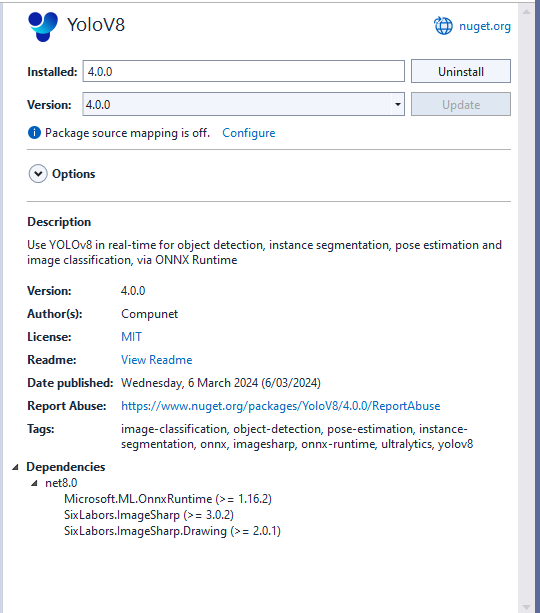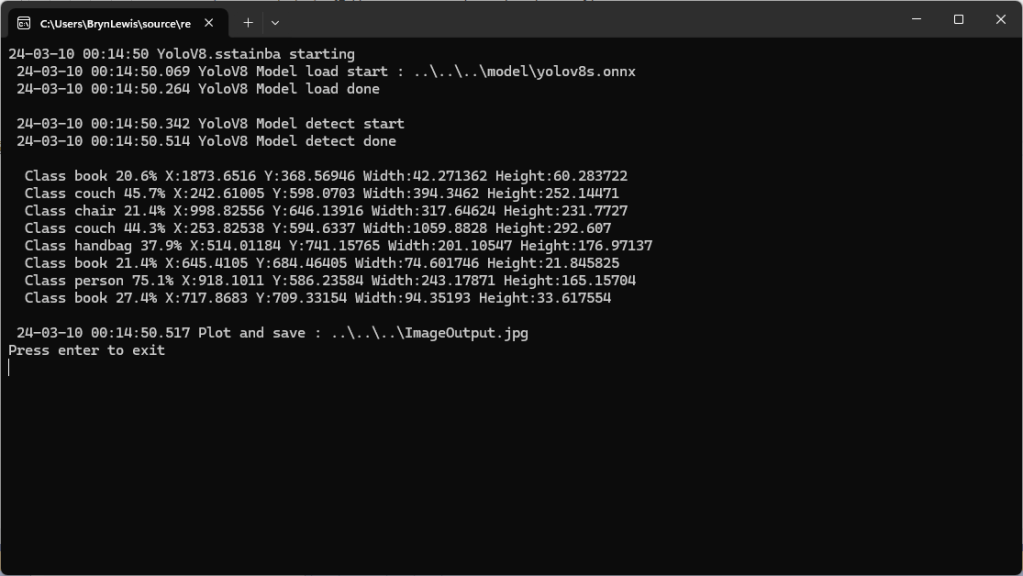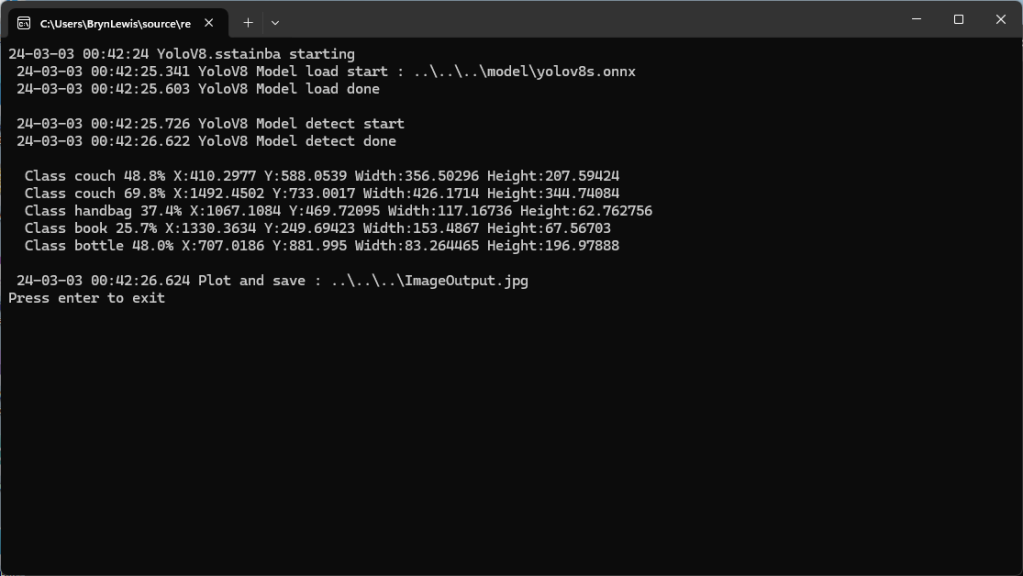public override List<YoloLabel> Labels { get; set; } = new List<YoloLabel>()
{
new YoloLabel { Id = 1, Name = "person" },
new YoloLabel { Id = 2, Name = "bicycle" },
new YoloLabel { Id = 3, Name = "car" },
new YoloLabel { Id = 4, Name = "motorcycle" },
new YoloLabel { Id = 5, Name = "airplane" },
new YoloLabel { Id = 6, Name = "bus" },
new YoloLabel { Id = 7, Name = "train" },
new YoloLabel { Id = 8, Name = "truck" },
new YoloLabel { Id = 9, Name = "boat" },
new YoloLabel { Id = 10, Name = "traffic light" },
new YoloLabel { Id = 11, Name = "fire hydrant" },
new YoloLabel { Id = 12, Name = "stop sign" },
new YoloLabel { Id = 13, Name = "parking meter" },
new YoloLabel { Id = 14, Name = "bench" },
new YoloLabel { Id = 15, Name = "bird" },
new YoloLabel { Id = 16, Name = "cat" },
new YoloLabel { Id = 17, Name = "dog" },
new YoloLabel { Id = 18, Name = "horse" },
new YoloLabel { Id = 19, Name = "sheep" },
new YoloLabel { Id = 20, Name = "cow" },
new YoloLabel { Id = 21, Name = "elephant" },
new YoloLabel { Id = 22, Name = "bear" },
new YoloLabel { Id = 23, Name = "zebra" },
new YoloLabel { Id = 24, Name = "giraffe" },
new YoloLabel { Id = 25, Name = "backpack" },
new YoloLabel { Id = 26, Name = "umbrella" },
new YoloLabel { Id = 27, Name = "handbag" },
new YoloLabel { Id = 28, Name = "tie" },
new YoloLabel { Id = 29, Name = "suitcase" },
new YoloLabel { Id = 30, Name = "frisbee" },
new YoloLabel { Id = 31, Name = "skis" },
new YoloLabel { Id = 32, Name = "snowboard" },
new YoloLabel { Id = 33, Name = "sports ball" },
new YoloLabel { Id = 34, Name = "kite" },
new YoloLabel { Id = 35, Name = "baseball bat" },
new YoloLabel { Id = 36, Name = "baseball glove" },
new YoloLabel { Id = 37, Name = "skateboard" },
new YoloLabel { Id = 38, Name = "surfboard" },
new YoloLabel { Id = 39, Name = "tennis racket" },
new YoloLabel { Id = 40, Name = "bottle" },
new YoloLabel { Id = 41, Name = "wine glass" },
new YoloLabel { Id = 42, Name = "cup" },
new YoloLabel { Id = 43, Name = "fork" },
new YoloLabel { Id = 44, Name = "knife" },
new YoloLabel { Id = 45, Name = "spoon" },
new YoloLabel { Id = 46, Name = "bowl" },
new YoloLabel { Id = 47, Name = "banana" },
new YoloLabel { Id = 48, Name = "apple" },
new YoloLabel { Id = 49, Name = "sandwich" },
new YoloLabel { Id = 50, Name = "orange" },
new YoloLabel { Id = 51, Name = "broccoli" },
new YoloLabel { Id = 52, Name = "carrot" },
new YoloLabel { Id = 53, Name = "hot dog" },
new YoloLabel { Id = 54, Name = "pizza" },
new YoloLabel { Id = 55, Name = "donut" },
new YoloLabel { Id = 56, Name = "cake" },
new YoloLabel { Id = 57, Name = "chair" },
new YoloLabel { Id = 58, Name = "couch" },
new YoloLabel { Id = 59, Name = "potted plant" },
new YoloLabel { Id = 60, Name = "bed" },
new YoloLabel { Id = 61, Name = "dining table" },
new YoloLabel { Id = 62, Name = "toilet" },
new YoloLabel { Id = 63, Name = "tv" },
new YoloLabel { Id = 64, Name = "laptop" },
new YoloLabel { Id = 65, Name = "mouse" },
new YoloLabel { Id = 66, Name = "remote" },
new YoloLabel { Id = 67, Name = "keyboard" },
new YoloLabel { Id = 68, Name = "cell phone" },
new YoloLabel { Id = 69, Name = "microwave" },
new YoloLabel { Id = 70, Name = "oven" },
new YoloLabel { Id = 71, Name = "toaster" },
new YoloLabel { Id = 72, Name = "sink" },
new YoloLabel { Id = 73, Name = "refrigerator" },
new YoloLabel { Id = 74, Name = "book" },
new YoloLabel { Id = 75, Name = "clock" },
new YoloLabel { Id = 76, Name = "vase" },
new YoloLabel { Id = 77, Name = "scissors" },
new YoloLabel { Id = 78, Name = "teddy bear" },
new YoloLabel { Id = 79, Name = "hair drier" },
new YoloLabel { Id = 80, Name = "toothbrush" }
};
Some of the label choices seem a bit arbitrary(frisbee, surfboard) and American(fire hydrant, baseball bat, baseball glove) It was quite tedious configuring the 80 labels in my Azure IoT Central template.
If there is an object with a label in the PredictionLabelsOfInterest list, a tally of each of the different object classes in the image is sent to an Azure IoT Hub/ Azure IoT Central.
The PredictionLabelsMinimum(optional) is then used to add additional labels with a count of 0 to PredictionsTally so there are no missing datapoints. This is specifically for Azure IoT Central Dashboard so the graph lines are continuous.
If any of the list of valid predictions labels is in the PredictionLabelsOfInterest list (if the PredictionLabelsOfInterest is empty any label is a label of interest) the list of prediction class counts is used to populate a Newtonsoft JObject which is serialised to generate a Java Script Object Notation(JSON) Azure IoT Hub message payload.




























































